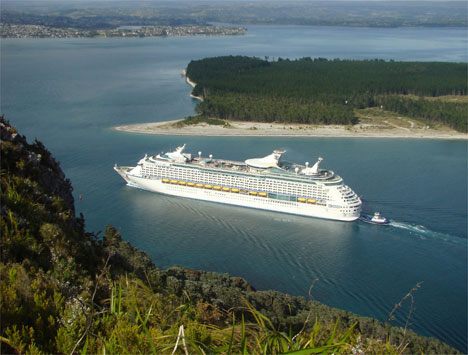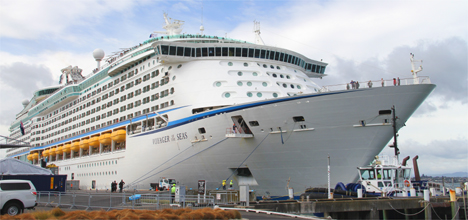Both passenger ships and cargo ships visiting the Port of Tauranga are growing in size, says Port of Tauranga CEO Mark Cairns.
Speaking on the port's $50million dredging programme expected to start next year at the general meeting recently, Mark says two of the largest cruise ships to call at the port made several visits in last financial year.
The 138,000 tons, 1020 ft long cruise ship Voyager of the Seas is one of the biggest cruise ships to dock at the Port of Tauranga.
 The 15-deckmega-liner can carry up to 3114 passengers with 1181 crew.
The 15-deckmega-liner can carry up to 3114 passengers with 1181 crew.
'Last year we had regular calls from 312metre and 317metre cruise ships - the largest ever to visit Tauranga and we sent our pilots to Australia for specialised training to ensure they could handle these ships in all weather conditions,” says Mark.
The dredging programme will make Tauranga the first New Zealand port able to host container ships with a capacity of 5000 to 6000 TEUs (Twenty foot Equivalent Units) at low tides.
The dredging will also allow larger bulk cargo ships to visit Tauranga. There are already bulk cargo customers talking about utilising larger ships, says Mark.
'The efficiency gains of these larger ships are estimated at more than $300million per year for our exporters and importers.
'These sorts of productivity gains will be essential if New Zealand is to achieve the Government's goal of increasing exports from 30 per cent to 40 per cent of Gross Domestic Product.”
During the year Port of Tauranga cemented its position as the largest container port in the country.
The Sulphur Point terminal became the largest in New Zealand in 2012 when volumes grew to just under 800,000 TEUs.
'Some people believed that this was purely attributable to the containers diverted from Auckland, during the period of industrial action up there,” says Mark.
'In the 2013 financial year, however, we increased our container volumes again, to nearly 850,000 TEUs.”
The container terminal now hosts 16 separate international services - more than any other port in the country.
Shippers are recognising that Port of Tauranga offers a quicker and more flexible route to international markets, thanks to the frequency of these visits and our world-class productivity, says Mark.
Trans-shipped container numbers increased by 12 per cent over the year, or 109 per cent since 2011. Trans-shipment is where containers are transferred from a vessel into the container terminal and then out of the terminal again, usually onto a larger vessel (or vice-versa for imports).
Trans-shipped containers now represent a quarter of all containers handled at the terminal, showing a clear trend to Tauranga consolidating its role as New Zealand's hub port.
'Our new berth extension at the container terminal allows us to accommodate three large vessels simultaneously. For our customers, that means a greater choice of berth windows, booking flexibility and greater crane intensity for loading and unloading,” says Mark.
Log exports are expected to increase in the next five years, as a significant swathe of production forests reach maturity.
The port's removed a storage shed to create further marshalling space for ship loading, and has sealed all log marshalling areas.
The industry consensus is that exports will continue to grow, on the back of strong demand from China, which now receives nearly 60 per cent of the logs exported from Tauranga, says Mark.
Dairy product exports grew by 27 per cent to 1.6million tonnes due to the consolidation of Fonterra/Kotahi cargo through Tauranga. Frozen meat exports also increased in volume by eight per cent.
'In the last two years we have increased container slot capacity has been increased by 30 per cent and refrigerated container plugs by 60 per cent over the last two years to accommodate growth in these types of cargoes,” says Mark.
Kiwifruit export volumes fall eight per cent as a result of the Psa-V virus. Some recovery is expected in the next year or two.
'Total imports were down slightly, reducing three per cent to just over six million tonnes,” says Mark.
'This was primarily due to reduced demand locally for fertiliser and grain due to the 2013 drought.”
Buying a 50 per cent stake in PrimePort Timaru and terminal concession to operate 100 per cent of the container terminal gives Port of Tauranga the opportunity to marshal South Island cargo to be trans-shipped through Tauranga on its way to overseas markets.
'Exporters will have more choice and be able to access the economies of scale from larger ships that I referred to earlier,” says Mark.
Tauranga will take over operation of the Timaru the Timaru Container Terminal in December.
'We see significant growth potential in the mid to south Canterbury region. It has a number of large scale irrigation projects planned and a burgeoning dairy industry as well as primary produce processing, fishing and forestry companies,” says Mark.



1 comment
Hmmm !!
Posted on 29-10-2013 12:02 | By Ross01
A major problem as I see it is that It is becoming increasingly difficult to see the ocean from Tauranga due to the piles of unused (and I presume unseaworthy)containers. Whose responsibility is it to dispose of these eyesores?
Leave a Comment
You must be logged in to make a comment.